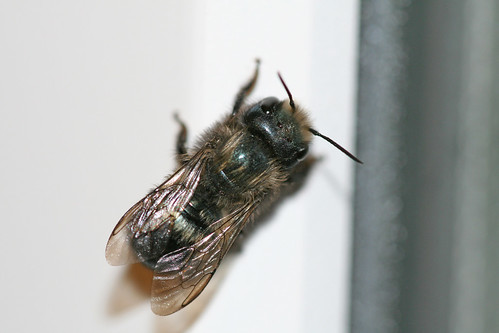 I've been under the weather since last week end and really haven't been outside much since Tuesday evening. So I guess nature decided to come to me-at least in a more pleasant form than a cold virus. We had just finished watching the KU Villanova game when I spotted this bee flying around the living room light fixture. Turns out to be a solitary bee in the genus Osmia a common visitor in my yard where they like to visit Vinca minor. Well since it is harmless, and especially since it was a male bee..I just let it fly around and sat back down to nurse my cold.
I've been under the weather since last week end and really haven't been outside much since Tuesday evening. So I guess nature decided to come to me-at least in a more pleasant form than a cold virus. We had just finished watching the KU Villanova game when I spotted this bee flying around the living room light fixture. Turns out to be a solitary bee in the genus Osmia a common visitor in my yard where they like to visit Vinca minor. Well since it is harmless, and especially since it was a male bee..I just let it fly around and sat back down to nurse my cold. But a few minutes later came another bee-this time a female and then another female. Now this presented a little mystery-where were they coming from? After all one bee...OK it got in through a crack in a window fixture somewhere or maybe through the mechanism for the patio door. That has happened before. But that didn't make sense. I remembered that Osmia are hole nesters so maybe there is a hole somewhere that goes from inside the house to the outside. That would be disturbing since Osmia use preexisting cavities-either hollow stems or holes bored by some other insect. I looked around and couldn't find any inside and decided to let the matter rest, take some pictures and go to sleep. Seems I 've doing a lot of that this week!
But a few minutes later came another bee-this time a female and then another female. Now this presented a little mystery-where were they coming from? After all one bee...OK it got in through a crack in a window fixture somewhere or maybe through the mechanism for the patio door. That has happened before. But that didn't make sense. I remembered that Osmia are hole nesters so maybe there is a hole somewhere that goes from inside the house to the outside. That would be disturbing since Osmia use preexisting cavities-either hollow stems or holes bored by some other insect. I looked around and couldn't find any inside and decided to let the matter rest, take some pictures and go to sleep. Seems I 've doing a lot of that this week! The males are about a third smaller than the females-the females are about 10mm long and have shorter antennae than the males. Two of the bees decided to mate on my living room rug as well-male on top as is typical for most insects.
The males are about a third smaller than the females-the females are about 10mm long and have shorter antennae than the males. Two of the bees decided to mate on my living room rug as well-male on top as is typical for most insects. This morning I realized that we still had a couple of wooden chairs that normally sit on our patio; we had brought them in as extra chairs for Easter dinner and I just haven't gotten them back outside. If the bees somehow had developed in the chair I ought to see the remains of a mud nest plug below the chair. Sure enough the a nest plug sat under the second chair.
This morning I realized that we still had a couple of wooden chairs that normally sit on our patio; we had brought them in as extra chairs for Easter dinner and I just haven't gotten them back outside. If the bees somehow had developed in the chair I ought to see the remains of a mud nest plug below the chair. Sure enough the a nest plug sat under the second chair. In my best CSI mode I took a picture and carefully upended the chair revealing the nest. The original hole is 10mm in diameter, the actual nest opening is roughly 5mm in diameter.
In my best CSI mode I took a picture and carefully upended the chair revealing the nest. The original hole is 10mm in diameter, the actual nest opening is roughly 5mm in diameter. And the nest was still occupied! Also there is still another nest in the other side of the same piece of wood.
And the nest was still occupied! Also there is still another nest in the other side of the same piece of wood.So after getting my pictures of the new bee, I put the chair outside. That will set my wife at ease.
 Osmia are important native pollinators and are even being raised and used commercially. They are in high demand in orchards given the decline in honey bee populations. See Osmia.com.
Osmia are important native pollinators and are even being raised and used commercially. They are in high demand in orchards given the decline in honey bee populations. See Osmia.com.Full sized images are on flickr and clicking on this bee will take you there:

No comments:
Post a Comment